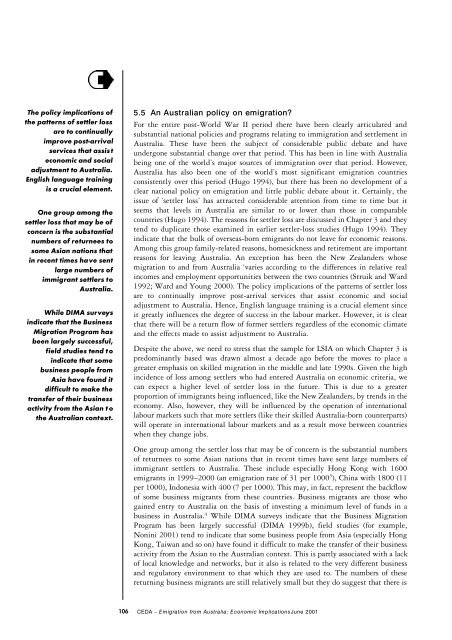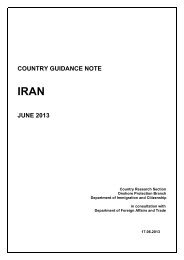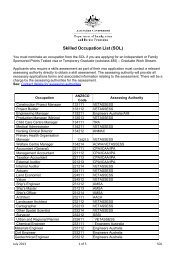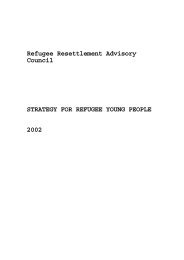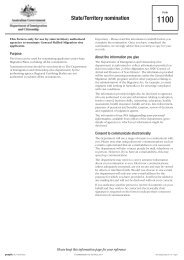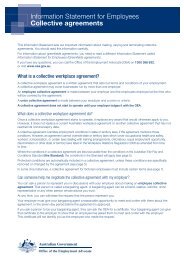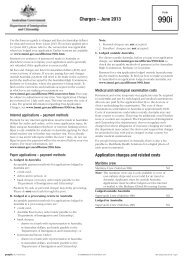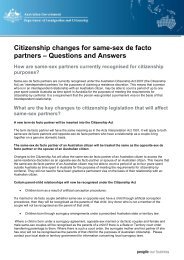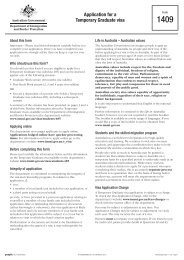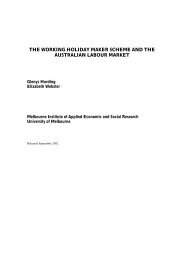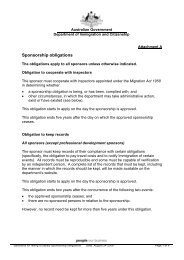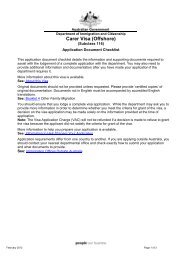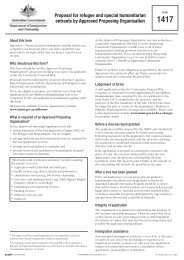part three - Department of Immigration & Citizenship
part three - Department of Immigration & Citizenship
part three - Department of Immigration & Citizenship
Create successful ePaper yourself
Turn your PDF publications into a flip-book with our unique Google optimized e-Paper software.
The policy implications <strong>of</strong><br />
the patterns <strong>of</strong> settler loss<br />
are to continually<br />
improve post-arrival<br />
services that assist<br />
economic and social<br />
adjustment to Australia.<br />
English language training<br />
is a crucial element.<br />
One group among the<br />
settler loss that may be <strong>of</strong><br />
concern is the substantial<br />
numbers <strong>of</strong> returnees to<br />
some Asian nations that<br />
in recent times have sent<br />
large numbers <strong>of</strong><br />
immigrant settlers to<br />
Australia.<br />
While DIMA surveys<br />
indicate that the Business<br />
Migration Program has<br />
been largely successful,<br />
field studies tend to<br />
indicate that some<br />
business people from<br />
Asia have found it<br />
difficult to make the<br />
transfer <strong>of</strong> their business<br />
activity from the Asian t o<br />
the Australian context.<br />
5 . 5 An Australian policy on emigration?<br />
For the entire post-World War II period there have been clearly articulated and<br />
substantial national policies and programs relating to immigration and settlement in<br />
Australia. These have been the subject <strong>of</strong> considerable public debate and have<br />
undergone substantial change over that period. This has been in line with Australia<br />
being one <strong>of</strong> the world’s major sources <strong>of</strong> immigration over that period. However,<br />
Australia has also been one <strong>of</strong> the world’s most significant emigration countries<br />
consistently over this period (Hugo 1994), but there has been no development <strong>of</strong> a<br />
clear national policy on emigration and little public debate about it. Certainly, the<br />
issue <strong>of</strong> ‘settler loss’ has attracted considerable attention from time to time but it<br />
seems that levels in Australia are similar to or lower than those in comparable<br />
countries (Hugo 1994). The reasons for settler loss are discussed in Chapter 3 and they<br />
tend to duplicate those examined in earlier settler-loss studies (Hugo 1994). They<br />
indicate that the bulk <strong>of</strong> overseas-born emigrants do not leave for economic reasons.<br />
Among this group family-related reasons, homesickness and retirement are important<br />
reasons for leaving Australia. An exception has been the New Zealanders whose<br />
migration to and from Australia ‘varies according to the differences in relative real<br />
incomes and employment opportunities between the two countries (Struik and Ward<br />
1992; Ward and Young 2000). The policy implications <strong>of</strong> the patterns <strong>of</strong> settler loss<br />
are to continually improve post-arrival services that assist economic and social<br />
adjustment to Australia. Hence, English language training is a crucial element since<br />
it greatly influences the degree <strong>of</strong> success in the labour market. However, it is clear<br />
that there will be a return flow <strong>of</strong> former settlers regardless <strong>of</strong> the economic climate<br />
and the effects made to assist adjustment to Australia.<br />
Despite the above, we need to stress that the sample for LSIA on which Chapter 3 is<br />
predominantly based was drawn almost a decade ago before the moves to place a<br />
greater emphasis on skilled migration in the middle and late 1990s. Given the high<br />
incidence <strong>of</strong> loss among settlers who had entered Australia on economic criteria, we<br />
can expect a higher level <strong>of</strong> settler loss in the future. This is due to a greater<br />
proportion <strong>of</strong> immigrants being influenced, like the New Zealanders, by trends in the<br />
economy. Also, however, they will be influenced by the operation <strong>of</strong> international<br />
labour markets such that more settlers (like their skilled Australia-born counter<strong>part</strong>s)<br />
will operate in international labour markets and as a result move between countries<br />
when they change jobs.<br />
One group among the settler loss that may be <strong>of</strong> concern is the substantial numbers<br />
<strong>of</strong> returnees to some Asian nations that in recent times have sent large numbers <strong>of</strong><br />
immigrant settlers to Australia. These include especially Hong Kong with 1600<br />
emigrants in 1999–2000 (an emigration rate <strong>of</strong> 31 per 1000 3 ), China with 1800 (11<br />
per 1000), Indonesia with 400 (7 per 1000). This may, in fact, represent the backflow<br />
<strong>of</strong> some business migrants from these countries. Business migrants are those who<br />
gained entry to Australia on the basis <strong>of</strong> investing a minimum level <strong>of</strong> funds in a<br />
business in Australia. 4 While DIMA surveys indicate that the Business Migration<br />
Program has been largely successful (DIMA 1999b), field studies (for example,<br />
Nonini 2001) tend to indicate that some business people from Asia (especially Hong<br />
Kong, Taiwan and so on) have found it difficult to make the transfer <strong>of</strong> their business<br />
activity from the Asian to the Australian context. This is <strong>part</strong>ly associated with a lack<br />
<strong>of</strong> local knowledge and networks, but it also is related to the very different business<br />
and regulatory environment to that which they are used to. The numbers <strong>of</strong> these<br />
returning business migrants are still relatively small but they do suggest that there is<br />
106 C E DA – Emigration from Australia: Economic ImplicationsJune 2001


